Introduction
The Leica Q2 Monochrom is a black and white version of the Q2 35mm full-frame compact camera that was launched in March 2019.
That’s right – as its name suggests, this camera only shoots in monochrome, not in colour.
It still uses a 47.3 megapixel, 35mm full-frame (24x36mm) CMOS sensor with no optical low pass filter, just like the Q2, but instead of the red, green and blue filter array found in the Q2, it has a sensor without those colour filters.
Subsequently, the Q2 Monochrom offers better noise performance at higher ISO values, because all of the light that exits the lens reaches the pixels on the sensor.
The amount of light reaching the pixels is effectively increased by around one stop, resulting in an ISO range of 100-100,000, versus 50-50,000 on the Q2 colour camera.
In addition, because there is no demosaicing process necessary to convert the image to colour, there is no loss of resolution as on the Q2, so the Monochrom version is able to capture finer detail and more subtle tonal gradations.
It also offers an extra 2 stops of dynamic range from the 14-bit Raw files – 13 stops of DR in total – when measured at ISO 200.
As it’s a black and white only camera, there are no colour modes for either stills or video on the Leica Q2 Monochrom.
Instead there are three different toning options for subtly altering the look of your in-camera images – blue, sepia and selenium.
Apart from the image sensor, the Leica Q2 Monochrom is otherwise virtually identical to the colour Q2 in terms of its features, performance, size and shape, and its build quality.
The only visual differences between the two models are the camera’s markings. The Q2 Monochrom has matte black paint, grey and white engravings and no famous red Leica logo on the front on the front, whereas the standard Q2 has more prominent yellow and red markings, especially on the lens barrel.
The Q2 Monochrom uses exactly the same image-stabilized Leica Summilux 28mm f/1.7 lens with 11 lenses in 9 groups (including 3 aspherical lens elements) as the Q2.
Likewise, it can also record 4K UHD and Cine4K video at 30/24 fps in the MP4 format and has a 3.68 megapixel OLED EVF, a touchscreen 3-inch LCD screen with 1,040,000 pixels, dust and moisture resistant weatherproofing, a top flash sync speed of 1/2000 sec. and a top electronic shutter speed of 1/40,000 sec., auto-focus speed of less than 0.15 second, and a continuous shooting rate of 10fps.
The only missing feature on the Q2 Monochrom is subject-tracking autofocus,which is unavailable becauses it requires colour information to work.
The recommended retail price of the Leica Q2 Monochrom is £4995 in the UK and $5995 in the US.
Ease of Use
 |
Leica have a long-standing association with black and white photography, so much so that that they are still the only major manufacturer to offer a dedicated monochrome camera in their range.
The new Q2 Monochrom joins the 40-megapixel M10 Monochrom that was launched earlier in 2020, the 24-megapixel Leica M Monochrom (Typ 246) from 2015, and the M9 Monochrom from 2012.
Whereas those M-branded cameras were all digital rangefinders, the Q2 Monochrom is the very first black and white fixed lens compact camera that Leica have produced.
What’s common to all four cameras is their shared effect on how you see the world through a black and white viewfinder instead of a colour one.
In addition to the technical advantages that a black and white sensor offers – better high ISO performance, greater resolution and increased dynamic range – using a monochrome camera changes how you photograph, placing a much stronger emphasis on the composition and structure of the image.
Unlike the M-series monochrome rangefinder cameras where you still see the world in colour, this is even more true on the Q2 Monochrom as the electronic viewfinder is rendered in black and white. So as soon as you pick the camera up and look through the viewfinder, you’re immersed in a colour-less vista, and subsequently you naturally start to think in black and white.
 |
One of the main downsides of using a B&W camera like this one are overblown highlights – once they’re blown out, it’s impossible to recover any detail, unlike a colour camera, so make doubly sure not to overexpose the critical areas of your image.
Secondly, whilst the camera offers three different toning options in two different strengths (weak or strong), you’ll really need to use actual 49mm filters on the thread on the front element of the lens, rather than relying on being able to add filter effects during post-processing, as you can with any colour camera.
Hand-crafted in Germany and feeling built like the proverbial tank when held in the palm, without being at all cumbersome to operate or transport, inevitably the price tag reflects such precision engineering.
In fact the Leica Q2 Monochrom is portable enough to be able to use it for shoot-from-the-hip photography – its size meaning that it won’t be as ‘threatening’ to passers by and subjects as a full-blown DSLR and lens would be.
That said, thanks to the fact that the optic is fixed here, it’s still too big to slot into either a jacket or trouser pocket.
The look of the Q2 Monochrom is very much classic Leica, coupled with some modern minimalism. The top plate therefore presents a clean and straightforward layout, with a recessed command dial/thumbwheel, raised shutter speed dial and forward-placed shutter release button, encircled by an on/off power lever.
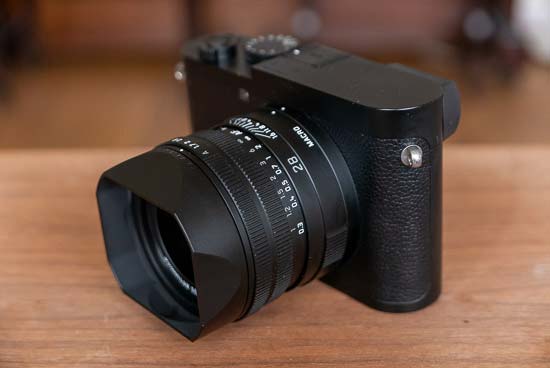 |
Flick the latter and the camera powers up nigh on instantly – so those used to shooting on premium mirrorless models or DSLRs will feel at home immediately in terms of the camera’s responsiveness.
As mentioned, at the front of the Leica Q2 Monochrom we have a fixed, as opposed to removable, lens.
The 28mm focal length provided is all encompassing and makes this Leica particularly suitable for landscape and travelogue photography, while a straightforward and clearly marked macro setting on the lens barrel allows subjects as close as 17cm to be captured, while otherwise the minimum focusing distance is a regular 30cm.
This is coupled with a bright/fast f/1.7 aperture, to allow for lower light shooting hand held (maximum f/2.8 in the macro mode). Because the lens is quite wide the user is naturally prompted to get quite close to their subjects if they want them to fill the frame, or the majority of it, to really make the most of the ‘bokeh’ opportunities offered by that maximum aperture.
On portraits we do get a slightly barreling effect on facial features therefore, though it’s hardly ugly. Incidentally, the manually selectable aperture range extends from f/1.7 up to f/16 with an automatic setting provided too.
Incidentally, the lens and aperture provided here is the same as that of the original 2015 ‘Q’ – Leica hasn’t chosen to throw the baby out of the bathwater and has retained what it says proved popular with regard to the original.
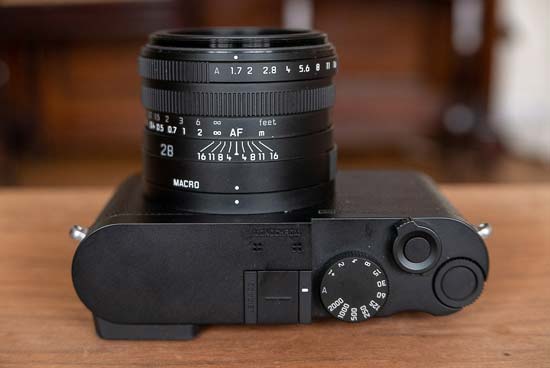 |
Impressively the lens is optically stabilized, a surprising feature given the wide-angle, full-frame nature of the lens, which coupled with the impressive noise performance at high ISOs makes it very easy to hand-hold in less than perfect lighting conditions and still achieve pin-sharp results.
Cleverly the Auto OIS option only operates at shutter speeds slower than 1/60th a second, otherwise it’s turned off to ensure optimum sharpness, making it a better choice than leaving the system on all of the time.
In addition to the 28mm optical focal length, the Q2 Monochrom provides three different crop modes that simulate longer focal lengths.
At the press of the small unmarked button next to the rear thumbgrip on the rear of the camera, you switch to 35mm, 50mm and 75mm crop modes, with a rectangular overlay displayed to help with composition.
The 35mm equivalent crop provides 30 megapixels resolution, the 50mm crop is equivalent at 15 megapixels, and the 75mm crop is equivalent to 7 megapixels.
These digital crops are only applied to the JPEG files, with a full-size 47 megapixel DNG Raw file also recorded at the same time.
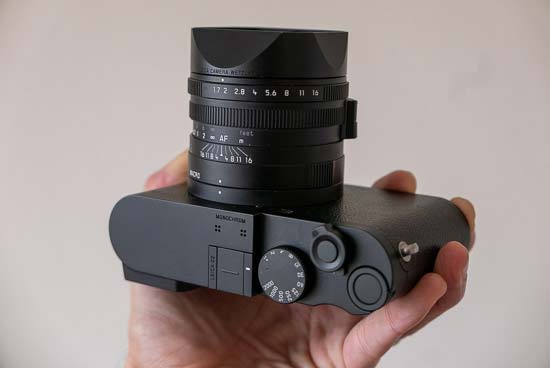 |
As the camera is cropping into the full-size image, rather than interpolating up a la most digital zooms, there’s no degredation of the image quality, just a reduction in the megapixel count.
You could of course apply similar crops yourself during post-processing, but providing them in-camera has the main added benefit of making composition much easier and more intuitive.
There is no built-in flash provided on the Leica Q2 Monochrom, although there is a provided hotshoe for the addition of flash, should that be required. Leica has additionally provided a screw-on/screw off lens hood, should you wish to use it as an additional aid to preventing lens flare, or avoid unwanted artefacts in brighter conditions.
The Leica Q2 Monochrom’s 225-point contrast-based auto-focus system has a response speed of 0.15 seconds, which is quick enough for most situations that the camera will encounter. It also works well in low-light environments, no doubt helped by the lens’ fast maximum aperture.
It offers multi-field, field and spot modes, the latter allowing the positioning of the AF point virtually anywhere within the frame, along with an effective face-detection system that proved to be both quick and accurate. There’s no eye-AF mode, though, or subject-tracking, the latter due to the monochrome sensor.
Peace of mind is provided, if you don’t quite trust what you are seeing, by a cross hair visible through the camera’s eye level electronic viewfinder, or touch screen LCD below. This flashes in green upon auto focus being achieved, though is inevitably harder to see on the back screen in brighter conditions.
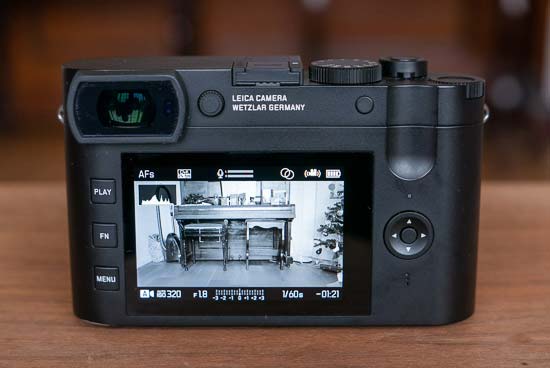 |
Leica may be pitching this as a full frame digital camera that’s easy to use. However newcomers will require a period of familiarity, largely because this is a camera that rewards getting hands on, rather than just pointing and shooting. A case in point is the lens rings that control many of the camera’s key settings, enabling precise adjustments on the fly.
Unsurprisingly the Leica Q2 Monochrom’s focus can be controlled via said rings, though the means of switching between AF and MF is quite subtle and initially well hidden.
In fact switching to manual focus occurs via a fingernail press of the so tiny you’ll miss it lever on the lens itself, that in turn allows the lens ring to move (it’s ‘stuck’ in place in auto mode) and manual distance markings on said barrel to be selected – whereby the camera provides the user with an enlarged portion of the subject on-screen, allowing focus to be more critically determined.
Go on and squeeze the shutter release button and you’ll be prompted to double-check the image has actually been taken, as the shutter release on the Leica Q2 Monochrom is so quiet you’re not alerted to the fact that the picture is taken.
While there’s not much, if anything, by way of a grip provided on this camera, it doesn’t feel like it will slip readily from your right hand. That’s due both to the solid feeling weight of the unit itself and the fact that there is a smooth indentation on the back plate for your thumb to rest in.
Coupled with this, the slightly roughened front plate design provides a degree of purchase for your forefingers and similarly prevents them from slipping around when you’re shooting with the Q2 Monochrom.
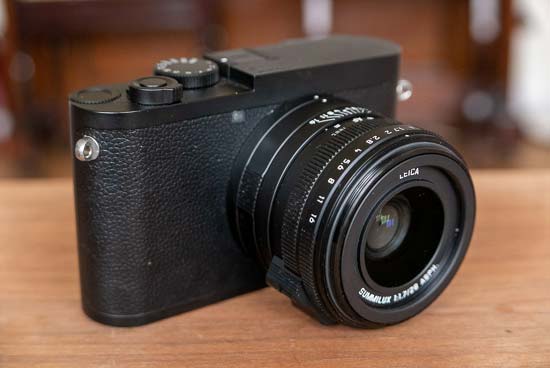 |
As we’d expect, when shooting on the Q2, images can be composed and reviewed via a choice of either the camera’s EVF or backplate LCD, the latter of which provides a degree of touch screen control. The EVF has a push in/pop out diopter adjustment wheel for use by those who are perhaps using the camera’s EVF when wearing spectacles.
With a supplied resolution of a whopping 3.68 million dots, when using the EVF it’s very easy to forget we’re not actually using the optical alternative, so realistic is the image presented to our pupil. The alternative of the LCD is a standard 3-inches in size and offers a lower 1.04 million-dot resolution.
On this camera you can shoot in JPEG format or Leica DNG – aka Leica’s own Raw files, that usefully can be opened in any regular image editor or image preview program. As one would expect, these can be either captured separately or – as we were shooting in the main – in tandem, with little if any noticeable slowdown.
The ability to shoot at 10fps with the manual shutter or 20fps with the electronic shutter is seriously impressive on a 47 megapixel camera, and helps to provide a range of subtly different frames from, if you prefer to shoot a sequence of shots in this way and select the “best” one later.
Aside from stills, video resolution goes all the way up to 4K here, though there is not a dedicated video activation or record button provided on the camera that readily indicates how to access this mode.
After a longer period of feeling our way around than we would have liked, we rather belatedly swiping right on the touchscreen LCD allowed us to move between stills and video capture instantly, as well as calling up a live histogram on-screen if so desired.
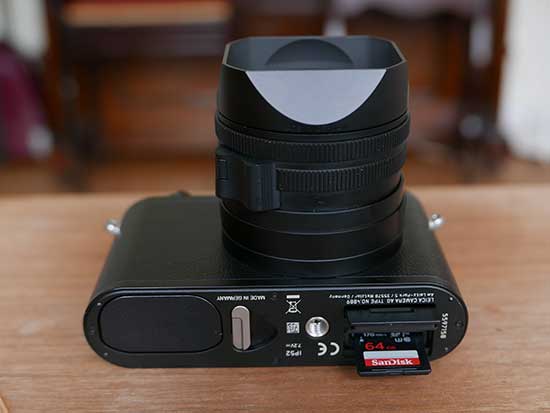 |
Alternatively you can also press the Menu button and press up on the navigation pad to toggle between the Photo and Video modes.
The Leica Q2 Monochrom may not be the most intuitive to camera to use from the off, but you quickly get used to its quirks. For example, a flick of the lever next to the battery compartment on the camera’s baseplate and the lithium ion rechargeable battery pops out – but not all the way.
We first tried pinching this between forefinger and thumb to extract it fully, before realising that a fairly subtle additional press with the thumb, or finger, will release it fully. We say a ‘subtle’ press is required, because alternatively a slightly harder press will simply push the battery fully back into place, and then we’re back to square one again.
Thankfully Leica has provided a standalone mains charger out of the box.
That’s just as well, as the Q2 Monochrom’s sleekly minimalist design has extended to the fact that there are no ports for USB or HDMI connectivity provided on the camera’s flanks, as we’d normally expect on any other digital camera.
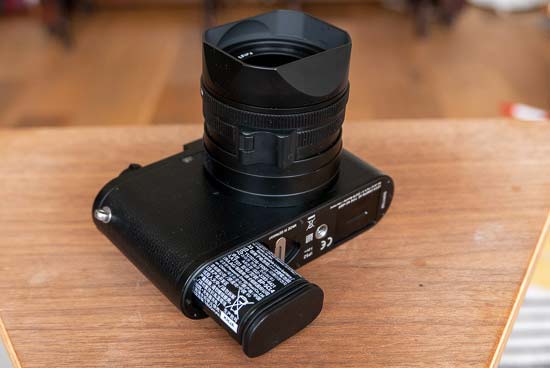 |
Back at the base of the unit, there is however a slide-open cover protecting a single UHS-II SD card slot.
The Q2 Monochrom continues to use an SL-series lithium battery in a Q model – the BP-SC14 to be exact – which, as on the Q2, has helped increase the amount of images that can be captured before it gives up the ghost.
This count has risen from the paltry 270 shots of the original ‘Q’ model to a more respectable 350-shot showing for the Q2 and Q2 Monochrom.
As with most recent Leica cameras, the Q2 Monochrom boasts both Bluetooth and Wi-fi connectivity for pairing with your smartphone and full compatibility with the Leica FOTOS app, which amongst other things provides seamless integration of Adobe Photoshop Lightroom straight into the app.
Overall the Leica Q2 Monochrom feels very much like a carefully honed tool, from its black and white sensor to its pared back user interface, from its perfectly balanced handling to its impeccable build quality.







